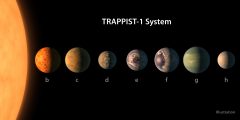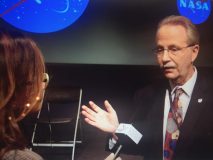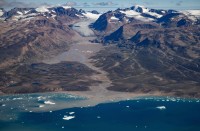
Credits: NASA/JPL-Caltech
By Dexter T. Manglicmot
Eagle News Correspondent
(WASHINGTON D.C., USA) – The National Aeronautics and Space Administration (NASA) announced that seven earth-like planets were seen orbiting a single star. They described this as a tremendous leap in the study of our universe because this is the first known system with this many planets that have the potential to support life outside our solar system.
“Using the Spitzer Space Telescope, we’ve discovered seven earth sized planets in the habitable zone around the same star, one star,” Paul Hertz, Director of the Astrophysics Division of NASA told Eagle News. “And all of these planets could have liquid water on their surfaces.”
The discovery was significant because many of the planets have the potential to support life as we know it on Earth.
“They all look like they have about the right temperature, similar to the Earth’s temperature,” Hertz said, “and so they are the kind of planets that life on Earth would be very comfortable on. So it’s very exciting, we found seven potentially habitable planets in the same solar system.”
The exoplanet system is called TRAPPIST-1, named for The Transiting Planets and Planetesimals Small Telescope (TRAPPIST) in Chile that found two of the planets in 2016.
https://youtu.be/HSesuAukWg4
Nasa’s Spitzer telescope aided by ground based telescopes confirmed the existence of the two planets and found five more in the system. Three of the seven planets fall in the habitable zone where liquid water can cool on the surface. This is important in creating an environment with the potential to support life.
“This discovery could be a significant piece in the puzzle of finding habitable environments, places that are conducive to life,” said Thomas Zurbuchen, associate administrator of the agency’s Science Mission Directorate in Washington. “Answering the question ‘are we alone’ is a top science priority and finding so many planets like these for the first time in the habitable zone is a remarkable step forward toward that goal.”
The system is located at a distance of 39 light years (235 trillion miles) which is relatively close to our solar system. It is made of planets that are similar to the size of the Earth but very close to each other and the orbits of all the planets to the host star are closer than Mercury is to our Sun.
The Spitzer, Hubble and Kepler telescopes along with NASA’s soon to be launched James Webb Space Telescope will continue to study the TRAPPIST-1 system and observe the atmospheres of the planets as well as analyze temperatures and surface pressures which are key factors in assessing the habitability of a planet.







